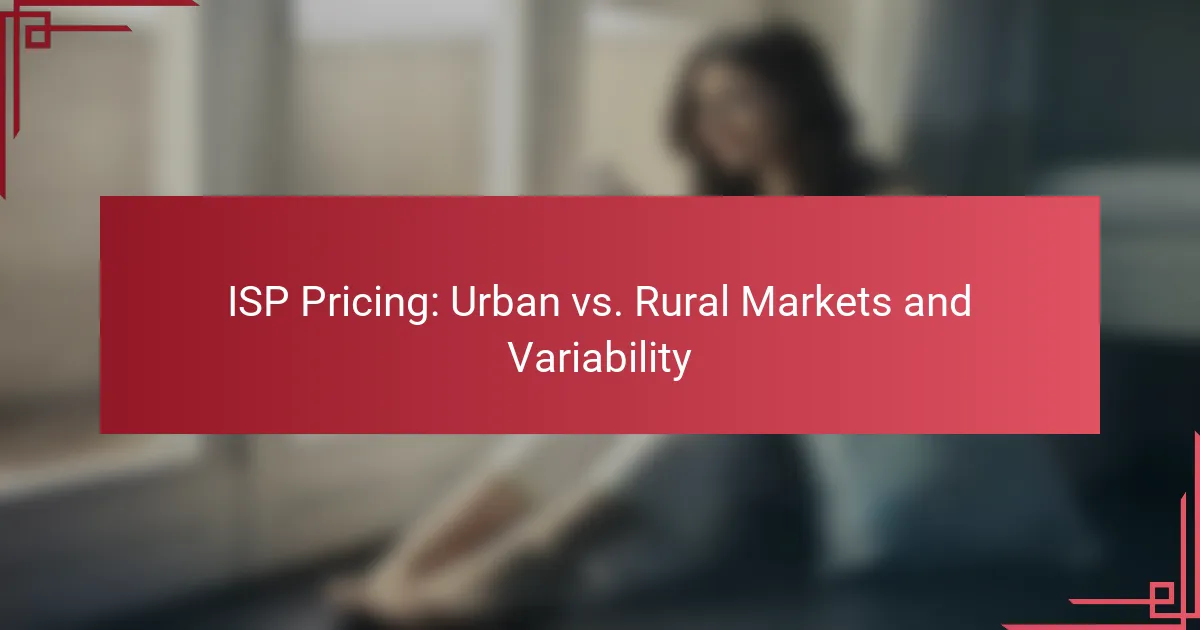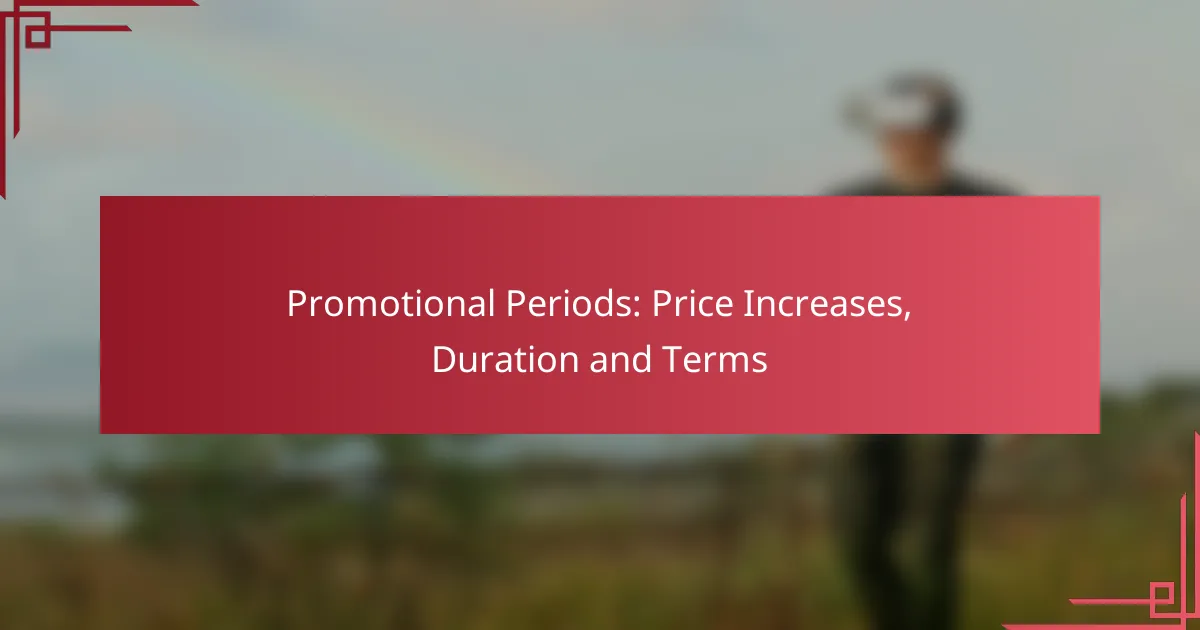ISP pricing exhibits notable disparities between urban and rural markets, largely driven by competition levels and infrastructure availability. In urban areas, consumers benefit from a plethora of service providers, resulting in lower average prices, while rural regions often contend with higher costs due to limited options and operational hurdles. Understanding these dynamics is essential for consumers to navigate their internet service choices effectively.
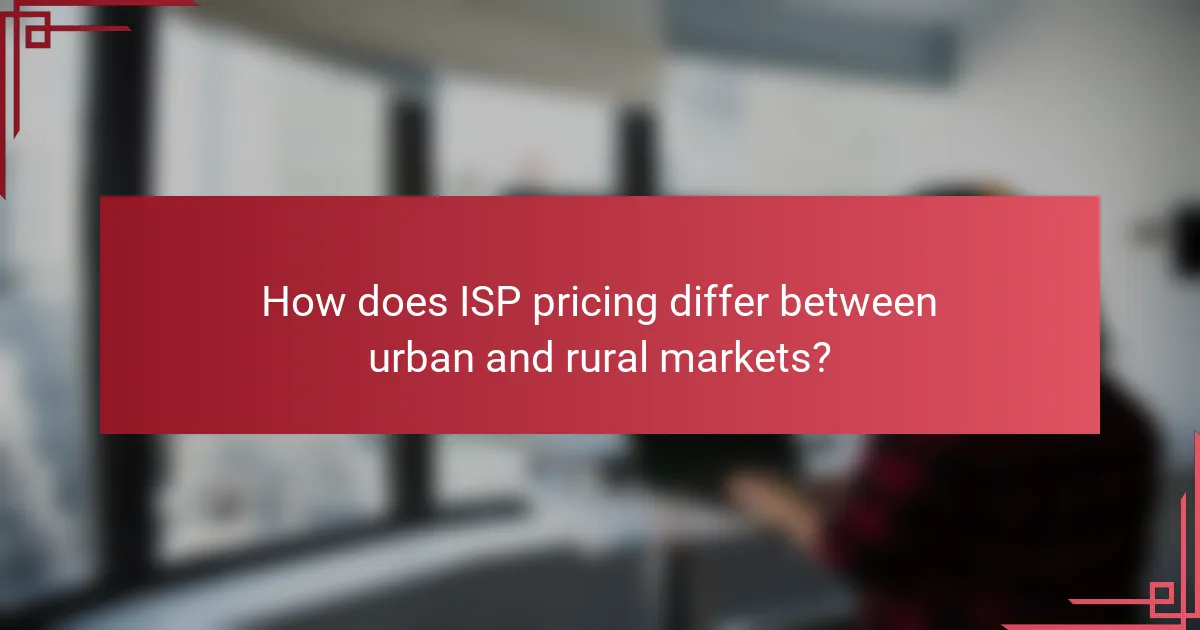
How does ISP pricing differ between urban and rural markets?
ISP pricing varies significantly between urban and rural markets, primarily due to differences in competition and infrastructure. Urban areas generally enjoy lower prices due to a higher number of service providers, while rural regions often face higher costs due to limited options and increased operational challenges.
Urban ISPs typically offer lower prices
In urban markets, ISPs compete vigorously to attract customers, leading to lower prices and better service packages. Consumers can often find plans ranging from $30 to $70 per month, depending on speed and data allowances.
Promotions and bundled services are common in cities, allowing customers to save even more. For example, many providers offer discounts for signing up for multiple services like internet, television, and phone.
Rural ISPs often charge higher prices
In contrast, rural ISPs frequently charge higher prices, with monthly fees often exceeding $70. This is due to the limited number of providers and the higher costs associated with maintaining infrastructure in less populated areas.
Rural customers may also experience slower speeds and data caps, which can further impact their overall satisfaction. Some areas may only have one or two ISPs, reducing competition and keeping prices elevated.
Market competition affects pricing
The level of competition in a given area is a key factor influencing ISP pricing. In urban settings, multiple providers lead to competitive pricing strategies, while rural areas often lack this competition.
Consumers in competitive markets should regularly compare plans and consider switching providers to take advantage of promotional offers. In rural areas, it may be beneficial to advocate for better service options or explore community initiatives aimed at improving internet access.

What factors influence ISP pricing variability?
ISP pricing variability is influenced by several key factors, including infrastructure availability, population density, and the regulatory environment. Understanding these elements can help consumers and businesses anticipate costs and make informed choices about internet service providers.
Infrastructure availability
The availability of infrastructure, such as fiber optic cables and wireless towers, significantly impacts ISP pricing. In urban areas, where infrastructure is often more developed, competition among providers can lead to lower prices. Conversely, rural regions may have limited infrastructure, resulting in higher costs due to the need for providers to invest in building out services.
For example, a city might have multiple ISPs offering plans ranging from $30 to $100 per month, while a rural area may only have one provider charging $70 to $150 for similar speeds. This disparity highlights how infrastructure directly affects pricing.
Population density
Population density plays a crucial role in determining ISP pricing. Higher population density typically leads to more customers per mile of infrastructure, allowing ISPs to spread their costs over a larger user base. This can result in lower prices for consumers in densely populated areas.
In contrast, rural areas with low population density may see ISPs charging more to cover the same infrastructure costs with fewer subscribers. For instance, an ISP might offer a plan for $50 in an urban setting but charge $100 in a sparsely populated region due to the lower number of potential customers.
Regulatory environment
The regulatory environment can influence ISP pricing by affecting how companies operate and compete. In regions with strong regulations promoting competition, ISPs may be incentivized to lower prices to attract customers. Conversely, areas with fewer regulations might see monopolistic practices, leading to higher prices.
For example, countries in the European Union often have regulations that encourage competition among ISPs, resulting in more affordable pricing options. In contrast, some rural areas in the United States may lack such regulations, allowing a single provider to dominate the market and set higher prices without competitive pressure.
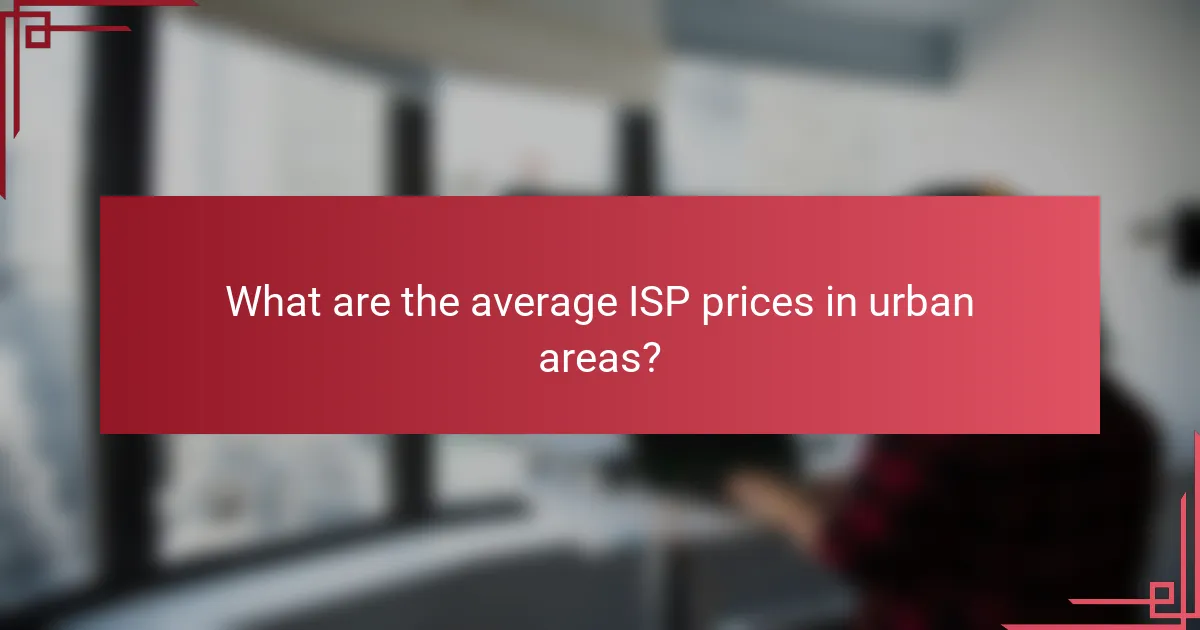
What are the average ISP prices in urban areas?
Average ISP prices in urban areas typically range from $50 to $100 per month, depending on the speed and type of service. Urban markets often have more competition, which can lead to better pricing and service options for consumers.
Average monthly cost in New York City
In New York City, the average monthly cost for internet service usually falls between $60 and $120. Factors influencing this range include the speed of the connection and the provider’s offerings.
Popular providers like Verizon Fios and Spectrum offer various plans, with speeds ranging from 200 Mbps to over 1 Gbps. Consumers should compare packages to find the best value for their needs.
Average monthly cost in Los Angeles
Los Angeles residents can expect to pay around $50 to $110 per month for internet service. Similar to New York City, the pricing varies based on the speed and type of service selected.
Providers such as AT&T and Spectrum offer competitive plans, with options that include both fiber and cable internet. It’s advisable to assess available deals and promotions to maximize savings.
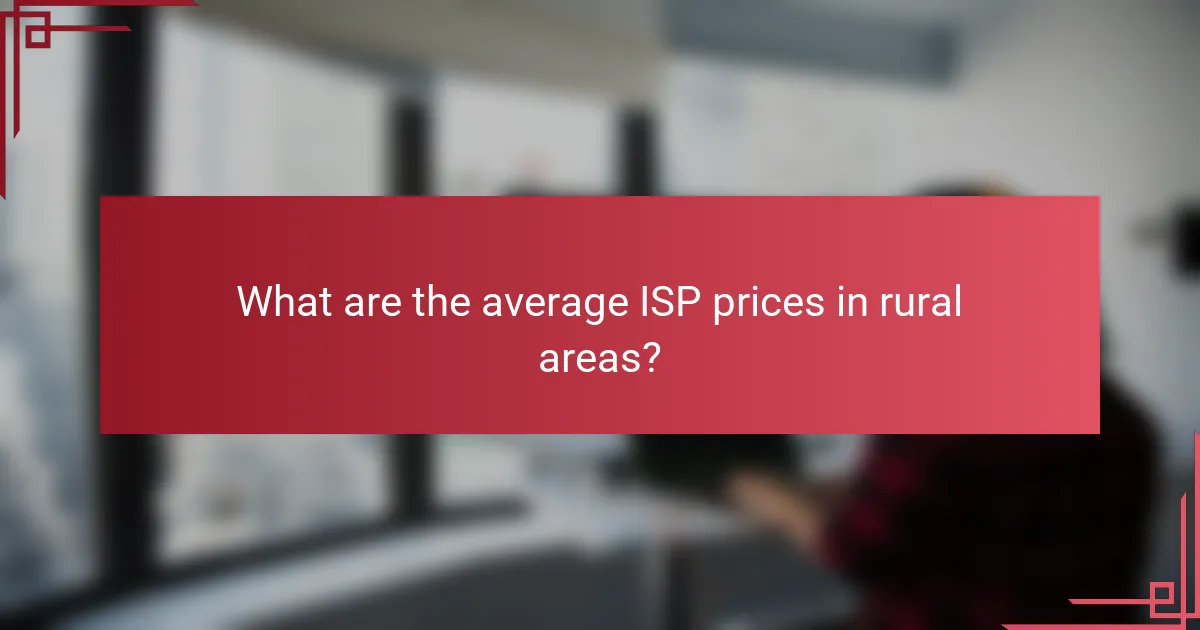
What are the average ISP prices in rural areas?
Average ISP prices in rural areas tend to be higher than in urban markets due to lower competition and infrastructure challenges. Monthly costs can vary significantly based on location, provider availability, and service type.
Average monthly cost in rural Texas
In rural Texas, the average monthly cost for internet service typically ranges from $50 to $100. Providers often charge more due to the expansive areas they need to cover and the limited number of customers in these regions.
Common options include DSL and satellite services, with satellite often being the more expensive choice. Customers should consider data caps and speed limitations when selecting a plan.
Average monthly cost in rural Montana
Rural Montana sees average ISP prices ranging from $60 to $120 per month. The higher costs can be attributed to the state’s vast geography and the challenges of reaching remote areas.
Many residents rely on fixed wireless or satellite internet, which can offer slower speeds compared to urban counterparts. It’s advisable to compare plans and check for any promotional offers that may lower initial costs.
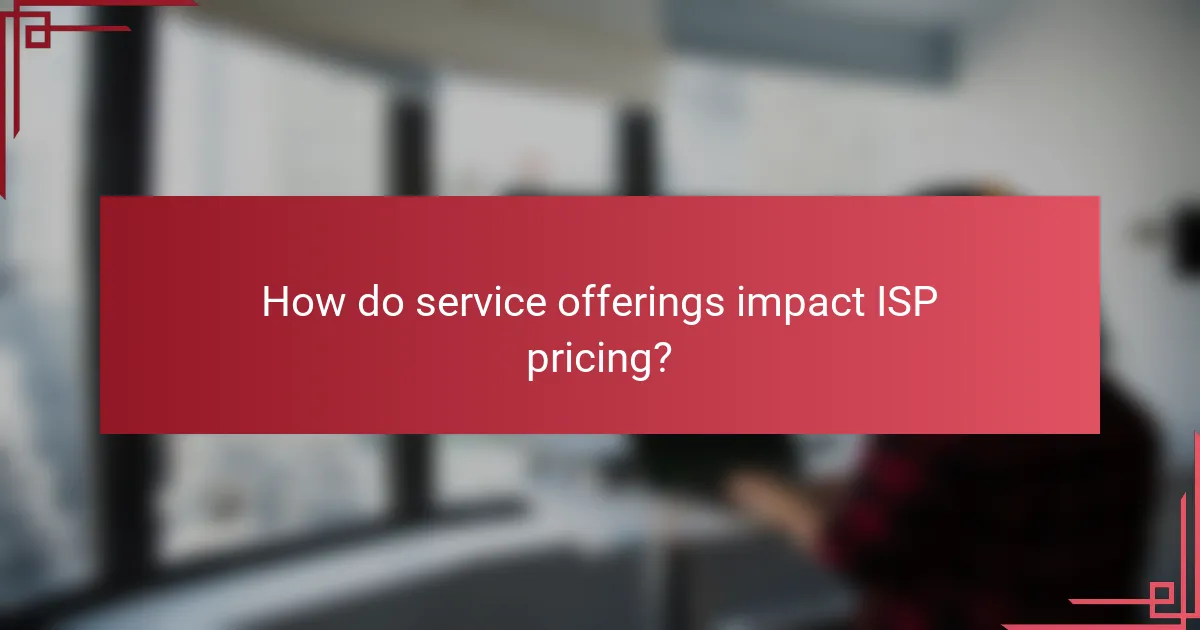
How do service offerings impact ISP pricing?
Service offerings significantly influence ISP pricing by determining the value and features included in a plan. Bundled services, higher speeds, and additional features can lead to variations in costs, affecting both urban and rural customers differently.
Bundled services reduce overall costs
ISPs often provide bundled services, which combine internet, television, and phone services into a single package. This approach typically results in lower overall costs compared to purchasing each service separately, as providers offer discounts to encourage customers to sign up for multiple services.
For example, a bundle might cost around $100 per month, while the individual services could total $130. Customers should compare bundled options with standalone services to identify the best value for their needs.
Higher speeds lead to increased pricing
As internet speeds increase, so does the pricing for those services. ISPs charge more for higher bandwidth because it requires more infrastructure and technology to deliver faster connections. Customers in urban areas may find competitive pricing for high-speed options, while rural customers often face limited choices and higher costs.
For instance, a basic plan offering speeds of 25 Mbps might cost around $50 per month, while a plan with speeds of 200 Mbps could be priced at $80 or more. When selecting a plan, consider your usage needs and whether the additional speed justifies the higher price.
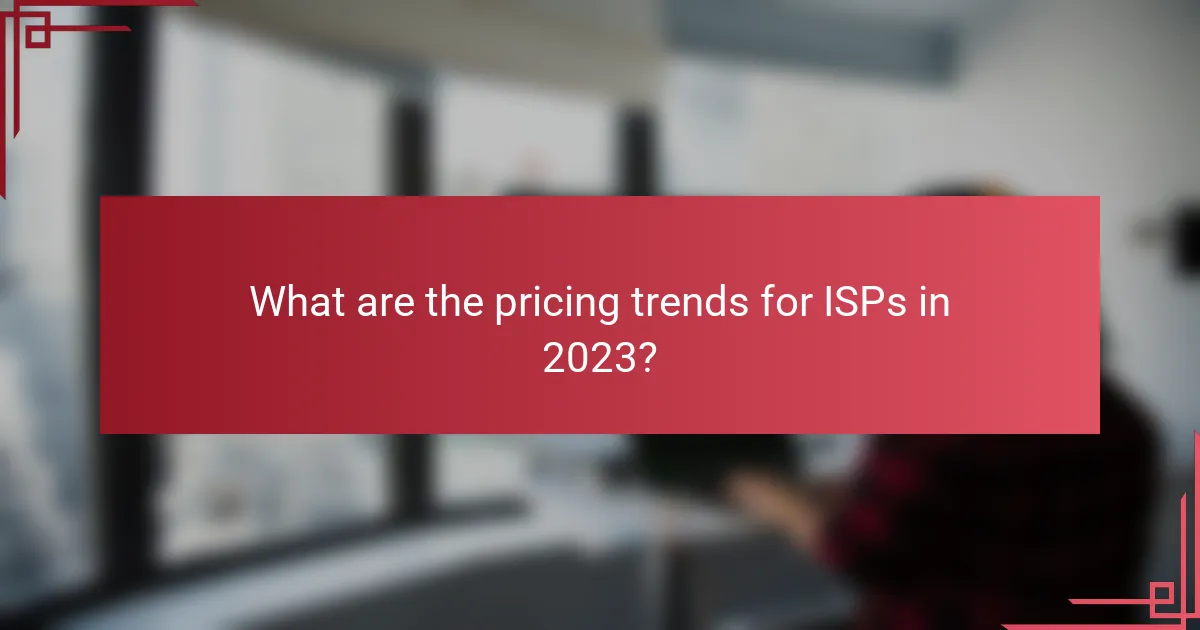
What are the pricing trends for ISPs in 2023?
In 2023, ISP pricing trends show a notable divergence between urban and rural markets, largely influenced by competition and regulatory initiatives. Urban areas typically enjoy lower prices due to higher competition, while rural regions often face higher costs due to limited options and infrastructure challenges.
Increased competition driving prices down
In urban markets, increased competition among ISPs is a significant factor in driving prices down. With multiple providers vying for customers, many companies offer promotional rates and bundled services to attract new subscribers.
For instance, consumers in metropolitan areas may find internet plans ranging from $30 to $70 per month for speeds of 100 Mbps to 1 Gbps. This competitive landscape encourages ISPs to enhance service quality while keeping prices in check.
Rural broadband initiatives affecting pricing
Rural broadband initiatives are aimed at improving internet access in underserved areas, but they can also impact pricing structures. Government programs and subsidies often help ISPs expand their networks, which can lead to lower prices over time.
However, initial costs for rural broadband can be higher, with plans often ranging from $50 to $100 per month for lower speeds, such as 25 Mbps. As infrastructure improves and competition increases, prices may gradually decrease, making internet access more affordable for rural residents.
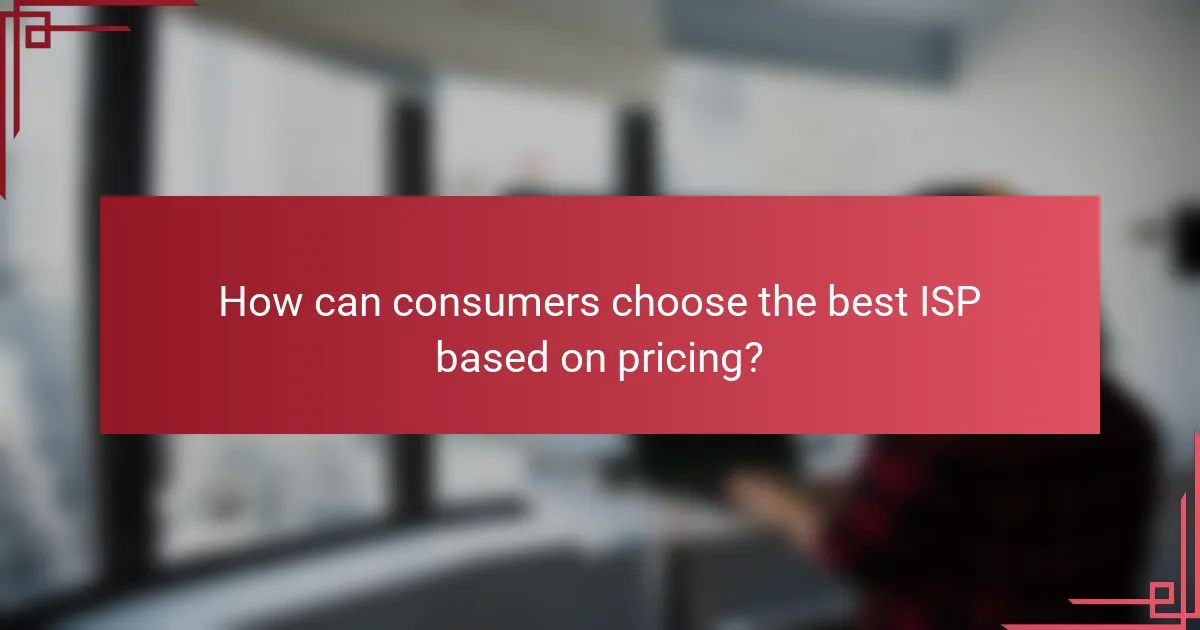
How can consumers choose the best ISP based on pricing?
Consumers can choose the best Internet Service Provider (ISP) by comparing pricing plans, understanding the services offered, and evaluating their specific needs. Key factors include monthly costs, data limits, speeds, and contract terms.
Understanding Pricing Models
ISPs typically offer various pricing models, including flat-rate plans, tiered pricing, and promotional offers. Flat-rate plans provide a consistent monthly fee for a set level of service, while tiered pricing adjusts costs based on usage or speed. Promotional offers can provide significant savings but may revert to higher rates after an initial period.
When evaluating these models, consider how much data you typically use and the speed you require for activities like streaming or gaming. For example, a flat-rate plan may be ideal for heavy users, while casual users might benefit from a tiered model that charges less for lower speeds.
Comparing Plans and Services
To choose the best ISP, consumers should compare plans from multiple providers, focusing on pricing, speed, and additional services. Look for hidden fees, such as installation costs or equipment rentals, which can affect the overall price. Many ISPs offer bundles that include phone or television services, which can provide additional savings.
Utilize online comparison tools to easily evaluate different ISPs. For instance, if you find a plan for $50 per month with a speed of 100 Mbps, check if other providers offer similar speeds for a lower price or with better terms.
Evaluating Contract Terms
Contract terms can significantly impact the total cost of an ISP plan. Many providers require a commitment of one to two years, which may include early termination fees if you decide to switch before the contract ends. Read the fine print to understand any penalties or conditions that could affect your decision.
Consider whether you prefer a month-to-month plan, which offers flexibility, or a long-term contract that may provide lower rates. Weigh the benefits of stability against the potential for changing your needs or finding a better deal in the future.
